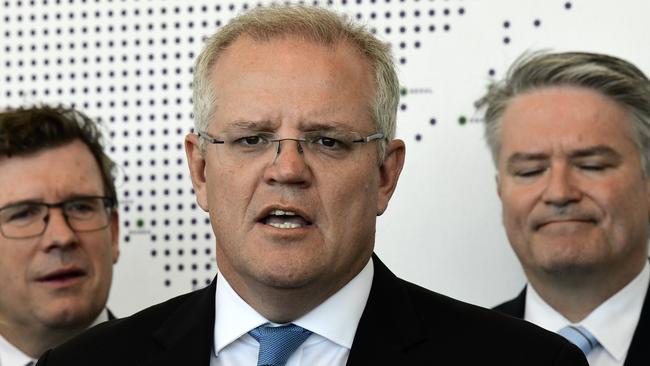Fears economic growth at its weakest since the GFC
The government is bracing for data which could show the weakest economic growth rate since the global financial crisis.

Scott Morrison has warned that the Australian economy entered a rough patch in the June quarter as the government braces for data that could show the weakest economic growth rate since the global financial crisis or the 1990s recession.
“I suspect the June quarter results will be soft,” the Prime Minister said as the Australian Bureau of Statistics released preliminary data showing a sharp fall in company inventories, which will cut nearly 0.1 per cent from GDP growth over the three months to the end of June.
While the ABS figures showed company profits rose strongly over the June quarter on the back of a surging mining and resources sector, a 0.9 per cent fall in inventory levels wiped out the previous quarter’s increase of 0.8 per cent, pointing to a soft retail environment. If inventories are low and sales are expected to rise in the future, businesses generally seek to build up stocks. Falling inventories can suggest businesses are failing to see strong sales.
Mr Morrison said the government’s tax cuts, policies to drive investments in skills and the expanding of trade agreements were designed to support the economy, which is under pressure amid a global trade spat between the US and China.
“All of this was part of this year’s budget in the full knowledge that we would be facing a very difficult quarter, particularly in that June quarter,” Mr Morrison said.
According to the ABS, strength in the mining sector outweighed weakness in manufacturing, with gross operating profits at Australian companies rising by 4.5 per cent in the three months to June.
Mining profits were up 11 per cent to a record high against a 3.5 per cent fall in manufacturing profits.
Josh Frydenberg said the May federal election, trade tensions and the impact of floods and droughts would likely leave economic growth figures “soft” over the June quarter.
“This is not an easy time for economies the world over, with Germany, the UK and Singapore, among others, recording negative growth in the June quarter,” the Treasurer said.
“However, the fundamentals of the Australian economy are strong. We have maintained our AAA credit rating, employment growth is more than twice the OECD average and the budget is coming back to surplus for the first time in more than a decade. We will continue to take the necessary actions which will ensure the Australian economy continues to grow.”
NAB economist Kaixin Owyong said the fall in inventories — mainly shown in falling retail stocks — would subtract 0.6 percentage points from economic growth figures set to be released on Wednesday, making the Reserve Bank of Australia’s forecast of 0.8 per cent GDP growth unlikely.
Wages and salaries were up a seasonally adjusted 1.4 per cent.
JPMorgan economist Ben Jarman said the fall in inventories suggested weakness in the production side of the economy and that “it seems hard to avoid the conclusion that the economy was weak” in the June quarter.
Pawel Borowski, an analyst at global ratings agency Fitch, said annual GDP growth rates in “virtually all” 20 large developed economies had been falling since mid-2018. “Weak domestic demand in China — evidenced more recently by a slowdown in housing starts — along with trade policy disruptions and related uncertainties are having widespread ramifications for the global economy,” Mr Borowski said.
CommSec senior economist Ryan Felsman said the economy remained sluggish, with still-tepid business and consumer confidence, despite recent stimulus efforts by the Reserve Bank and government. “Clearly more policy work needs to be done to boost growth,” Mr Felsman said.



To join the conversation, please log in. Don't have an account? Register
Join the conversation, you are commenting as Logout